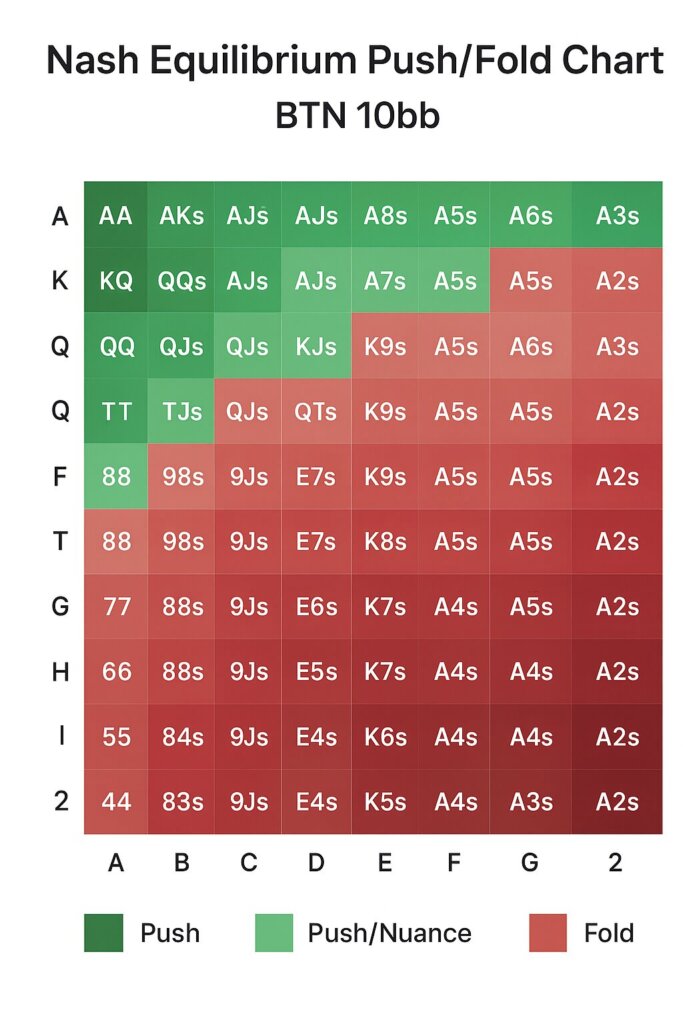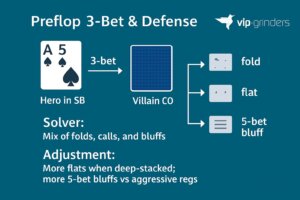Ultimate Texas Holdem Advanced Strategy (2025)
In 2025, advanced Texas Hold’em strategy matters more than ever. We live in a solver-driven era, where top players use cutting-edge AI tools to study optimal lines and ranges.
Player pools are tougher and more balanced, with most serious opponents understanding core poker math and GTO principles.
This is a different beast from beginner or intermediate strategy. Here, it’s about mastery: making finely tuned adjustments, understanding opponent tendencies, and applying professional-level concepts like exploitative deviations, range balancing, and multi-street planning.
To keep things clear, here’s the outline of what we’ll cover:
- Core Framework of Advanced Play: GTO vs Exploitative, Range Construction
- Advanced Preflop and Postflop Strategies
- Tournament-Specific Adjustments
- Deep Cash Game Concepts
- Tools, Study Methods & Mental Game
- Real Hand Case Studies

Core Framework of Texas Holdem Advanced Strategy Strategy
GTO vs Exploitative Play
Game Theory Optimal (GTO) strategy is the foundation for advanced poker. It means playing balanced ranges and making yourself unexploitable against any opponent. Solvers help us understand SPR, c-bet frequencies, bet sizing, and balancing bluffs with value bets. But pure GTO is a base, not a finish line.
In the real world, most opponents have glaring leaks—folding too much to 3-bets, over-defending their big blind, or never folding river. Exploitative play capitalizes on these tendencies for extra EV.
Example: if a villain folds 75% to 3-bets, widen your 3-bet range aggressively. If they call too wide in the big blind, tighten your range and bet bigger for value.
Range Construction & Balance
Your range should be flexible: polarized (mostly very strong hands and bluffs) or merged (incrementally strong hands without much bluffing), depending on board texture and opponent tendencies.
Use blockers—cards in your hand that reduce opponent’s likely holdings—to shape 3-bet and c-bet ranges. For example, 3-betting A5s blocks premium AA and AK combos, making it a strong semi-bluff candidate.
Visualizing your preflop 3-bet range by position and stack depth is crucial to maintaining balance and preventing leaks.
This framework underpins every decision made through the hand. Master it, and you’ll be far ahead of the average pro.
Texas Holdem Advanced Strategy Preflop
1. Positional Adjustments
Position dictates your range construction and aggression levels.
- Early position (EP) demands tight, premium-heavy open-raise ranges to avoid playing tricky postflop spots out of position.
- Mid position (MP) opens up slightly, while the cutoff (CO) and button (BTN) are your bombs-to-launch with wide, aggressive ranges—often opening 40-45% of hands at 100bb deep.
- The small blind (SB) and big blind (BB) require specialized defense and raise first-in (RFI) strategies because of their positional disadvantage.
A good benchmark: BTN open roughly 45% of hands, with a GTO fold-vs-3-bet rate near 55%. These percentages sharpen in higher stakes and tougher games.
2. 3-Betting & 4-Betting Theory
3-betting blends value hands with balanced bluffs. Value-to-bluff ratios shift by position and opponent tendencies—commonly between 70/30 and 50/50.
Cold 4-bets are power moves, typically narrow and value-heavy, but can be exploited if opponents fold too often. Knowing when and how to mix in bluffs on 4-bets, especially from the blind versus CO, is a key edge.
Example Hand: Hero 3-bets A5s from SB vs CO open. Villain 4-bets. Solver-approved responses often require a mix of fold, call, and 5-bet bluffs depending on stack sizes and player reads.
3. Short Stack & Deep Stack Adjustments
Tournament players should master push/fold charts for around 20bb effective stacks—this maximizes fold equity and survival in late stages. Deep-stack (200bb+) cash game play rewards speculative hands like suited connectors and small pairs, capitalizing on implied odds.
Visual aids like Nash equilibrium push/fold charts are invaluable tools for mastering short stack ranges and identifying profitable extensions in deep-stacked play.

Texas Holdem Advanced Strategy Postflop
1. Board Texture & Equity Distribution
Board texture defines how ranges hit and guides your betting strategy.
- Wet boards (coordinated with many draw possibilities) favor the caller’s range, typically requiring more cautious c-betting.
- Dry boards (disconnected, few draws) give the aggressor range advantage, justifying higher c-bet frequencies.
For example, on a K♠7♠2♦ flop, raiser’s range is often stronger, encouraging more aggressive play.
Use solver outputs to refine c-bet frequency by board type—balanced aggression minimizes exploitability.
2. Bet Sizing Theory
Bet sizes depend on hand strength, board texture, and strategic goals. Small bets (25-33% pot) apply pressure on wide ranges on dry boards to charge draws cheaply. Larger bets (66-150% pot), including overbets, polarize your range and deny equity, particularly on dynamic flops.
Multi-street planning is vital: your flop and turn bets set up optimal pot size ratios (SPR) for turn/river or all-in decisions.
Example Hand: Flop check-raise with strong draws and blockers controls pot size while semi-bluffing effectively.
3. Bluffing & Semi-Bluffing
Maintain balanced bluff frequencies to stay unpredictable—too many bluffs and you lose value, too few and you become exploitable. Optimal cards to barrel turns include overcards and cards shifting equity dramatically.
Example: Semi-bluff A♠5♠ on a Q♠9♦2♠ board runs multiple streets, leveraging blocker advantage and fold equity.
4. Advanced River Play
Polarized river betting involves betting either nuts or bluffs exclusively. Thin value betting captures marginal edges in close spots. The bluff-to-value ratio should approximate villain’s pot odds; for example, potting the river requires about one bluff for every two value bets (~33% bluffs).
Solver-generated tables on river bet frequencies by situation help perfect this balance.
Tournament-Specific Texas Holdem Advanced Strategy
1. ICM & Risk Premium
In tournaments, chips are not dollars. Understanding ICM (Independent Chip Model) is essential because survival value inflates the cost of risky plays—especially near bubbles and final tables.
This “risk premium” means you often tighten your range in marginal spots, avoiding calls or bluffs that might be profitable chip EV-wise but too risky dollar-wise. Conversely, big stacks can apply pressure, exploiting opponents’ need to preserve chips.
2. Adjusting to Blind Levels & Antes
Early tournament stages allow more speculative and deep-stack play. As blinds and antes rise, ranges tighten and aggression ramps up. Short stacks rely heavily on push/fold strategies, using Nash equilibrium charts to maximize fold equity. Deep stacks shift towards pressure plays and selective isolation raises to accumulate.
3. Exploiting Player Types in MTTs
Recreational players and regulars play very differently. Recreational opponents often make predictable mistakes—calling too wide, playing passive post-flop—which can be exploited by increasing bluff frequency and value betting thinner.
Online dynamics differ from live, so adjust your play based on the environment.
Cash Game Texas Holdem Advanced Strategy
1. Deep-Stack Adjustments
Cash games typically feature deep stacks (100bb+), demanding a fundamentally different approach than tournaments. Deep-stack play rewards probing opponents with overbets, multi-street bluffs, and well-planned pot control.
Hands like suited connectors and small pairs gain value due to implied odds. Understand how to navigate SPR (stack-to-pot ratio) to maximize pressure when you have the edge and minimize losses when behind.
2. Exploitative Play vs Pool Tendencies
Every poker pool has identifiable leaks. Online micro- and mid-stakes players fold too much to 3-bets or never fold river wide enough. Live games often feature predictable limp-callers and stubborn over-callers.
Identify these tendencies and adjust by increasing bluff frequency where opponents fold too much, or value bet thinly and tighten ranges where they call light. Exploitative thinking supplements your solid baseline strategy.
3. Volume & Hourly Maximization
Balancing win rate with hands per hour is crucial. Multi-tabling allows volume increases but can negatively impact decision quality if pushed too far. Know your comfort zone to sustain peak focus.
High stakes demand more patience and precision per hand; lower stakes reward aggression and volume. Use tracking tools to analyze hourly win rates versus volume tradeoffs to optimize your session planning.
Tools, Data & Study Methods
1. Solver Use (PioSolver, GTO+, MonkerSolver)
Solvers revolutionized poker study by providing near-optimal solutions to complex spots. The key is not to memorize outputs but to extract practical heuristics that you can apply at the table.
Example: understanding that dry A- and K-high boards favor frequent small c-bets helps frame post-flop decisions, rather than memorizing exact frequencies. Study a handful of critical spots deeply each week, then test those concepts in your own play.
2. HUDs & Tracking Software
Tracking software like PokerTracker and Hand2Note is indispensable for serious players. Key stats to monitor include VPIP, PFR, 3-bet frequency, and fold-to-c-bet. Using filters to identify and exploit population leaks (such as opponents who fold too much or call too often) is where you convert raw data into poker profits.
3. Database Review & Leakfinding
Regularly review your hand histories, focusing on losing spots like out-of-position 3-bet pots or missed fold opportunities. Analyze results by position, opponent type, and game format to spot subtle leaks before they sink your winrate.
This methodical leakfinding, coupled with corrective study, is essential for continuous improvement and higher ROI.
5 Professional Poker Disciplines
The mental game often separates good players from great ones. Peak performance in poker comes from emotional control, focused mindset, and disciplined routines.
- 1Tilt Control: Recognize early signs of tilt—frustration, impatience, or distraction—and implement stop-loss limits or mental reset techniques. Simple breathing exercises, short mindfulness breaks, or stepping away from the table can preserve your A-Game.
- 2Bankroll Management: Play stakes appropriate to your bankroll with enough buy-ins to weather variance. For cash games, keep 20-30 buy-ins for spikes in swings; for MTTs, 100+ buy-ins protect against big downswings.
- 3Identify Your A & C Game: Track your performance to find when you play your best (A Game) versus when mistakes creep in (C Game). Reproduce your A Game conditions (time of day, environment) and avoid playing when in C Game mode.
- 4Preparation & Routine: Successful pros develop pre-session rituals—nutrition, hydration, warm-up exercises, and mental check-ins—to enter the optimal mindset. Visualization of likely scenarios enhances decision-making clarity.
Real Hand Analysis Section (Case Studies)
Breaking down real hands is where theory meets practice. Reviewing advanced hands lets us see range construction, solver guidance, and exploitative deviations in action.
Hand 1: Preflop 3-Bet & Defense:
Hero in SB 3-bets A5s versus CO open. Villain 4-bets. Solver shows mixing folds, calls, and 5-bet bluffs depending on stack depths and reads. Player adjusts by flatting more in deep stacks and 5-betting premium bluffs when facing aggressive players.

Hand 2: Multi-Street Board Play
On a K♠7♠2♦ board, CO c-bets wide. Hero in BB defends with polarized range, balancing folding weak combos with raising nut draws and semi-bluffs. Turn barrel sizing controls pot for river decisions. Solver outputs confirm balanced bluff-frequency to value betting lines.
Hand 3: Bubble ICM Pressure
Near payout bubble, short-stack push/fold ranges tighten sharply to account for risk premium. Hero applies pressure with steals and shoves wider, capitalizing on opponents’ survival instincts. Hand history and ICM calculator reviews identify spots to exploit excessively tight opponents.
Final Thoughts on Texas Holdem Advanced Strategy
Advanced Texas Hold’em in 2025 demands being able to adapt quickly to different players and situations. It’s no longer enough to rely on static GTO solutions or basic exploitative ideas.
The game evolves constantly—with tougher opponents, more widespread solver knowledge, and AI-driven study tools. Mastery comes from deeply understanding theory, spotting leaks in real time, and dynamically adjusting your approach.
Continuous study, disciplined mental game control, and regular real hand review separate the elite from the field. Keep integrating solver insights sensibly, balance aggression with patience, and never compromise your mental edge.
Top 10 Advanced Texas Hold’em Strategy Takeaways (2025)
- 1Master GTO as your baseline: Understand balanced ranges, c-bet frequencies, and bet sizing from solvers—but never treat it as the final answer. Use it as a foundation to build your strategy.
- 2Exploit opponent leaks effectively: Identify tendencies such as over-folding to 3-bets or calling too wide in the big blind. Adjust your range and bet sizes accordingly to maximize EV.
- 3Adjust ranges by position and stack size: Open wider on the button and cutoff, tighten in early position. Use push/fold charts for short stacks; widen calling and bluffing ranges deep-stacked.
- 4Use blockers and balance range construction: Leverage blockers in your hand to craft polarized or merged ranges, increasing your semi-bluffing and value extraction opportunities.
- 5Plan multi-street bet sizing and board texture strategy: Size bets small on dry boards to pressure wide ranges, and bet larger on wet boards to polarize and deny equity. Your flop and turn sizing sets up proper SPR for later streets.
- 6Balance bluff-to-value ratios, especially on the river: Match your bluff frequency roughly to the pot odds you give opponents. For pot-sized river bets, bluff about one in three bets to stay unexploitable.
- 7In tournaments, master ICM and risk premium considerations: Tighten marginal spots near bubbles to protect your stack and pressure opponents who are survival-focused.
- 8Exploit recreational players and regulars differently in MTTs: Bluff more and thin value bet versus the recreational crowd. Use balanced, GTO-based approaches with selective deviations versus tough regs.
- 9Tilt control and mental game mastery are crucial: Recognize tilt early and use stop-losses, breaks, and mental resets to maintain your A-game. Balance volume with rest to avoid burnout.
- 10Leverage modern tools and study methods: Prioritize heuristic learning from solvers over rote memorization. Use HUDs and databases for leak-finding and opponent profiling. Regularly review hands with solver insights to improve.
Advanced Texas Hold'em Strategy FAQs
What’s the difference between GTO and exploitative play at high stakes?
GTO aims to make you unexploitable by balancing value and bluffs perfectly. High stakes pros start here but gain extra EV by exploiting opponent leaks—widening or tightening ranges based on opponent tendencies.
How often should I study solvers without overthinking?
Study 1-2 critical spots deeply per week, then apply lessons practically. Avoid paralysis by analysis.
How do I decide bet sizing in advanced play?
Let board texture, stack depth, and polarization guide size. Small bets pressure wide ranges on dry boards; large bets polarize on dynamic textures. Multi-street planning sets the stage for pot control or all-in.
What is the ideal bluff-to-value ratio on the river?
Roughly match your bluffs to your opponent’s pot odds. For example, potting the river calls for about 1 bluff per 2 value bets (~33% bluffs).
How do I adjust to deep stacks (200bb+)?
Deep stacks encourage wider calling ranges and more bluffing rivers to exploit overfolding. Overbets and thin value bets increase in frequency.
How does ICM affect tournament decisions?
ICM inflates survival value over chip EV. Tighten ranges near bubbles, fold marginal calls, and apply maximum pressure with big stacks.
Do solver solutions work for live poker?
Not precisely. Live players tend to deviate more, allowing exploitative play. Online, solver-based ranges are closer to the norm, especially at high stakes.
Should I flat strong hands preflop sometimes?
Yes—mix flatting premiums sparingly to balance ranges, mainly deep-stacked and against tough opponents. Otherwise, straightforward 3-betting is often more profitable.
What are common leaks among advanced players?
Over-bluffing turns, under-bluffing rivers, poor multi-street planning, and too rigidly sticking to solver lines in exploitable spots.










